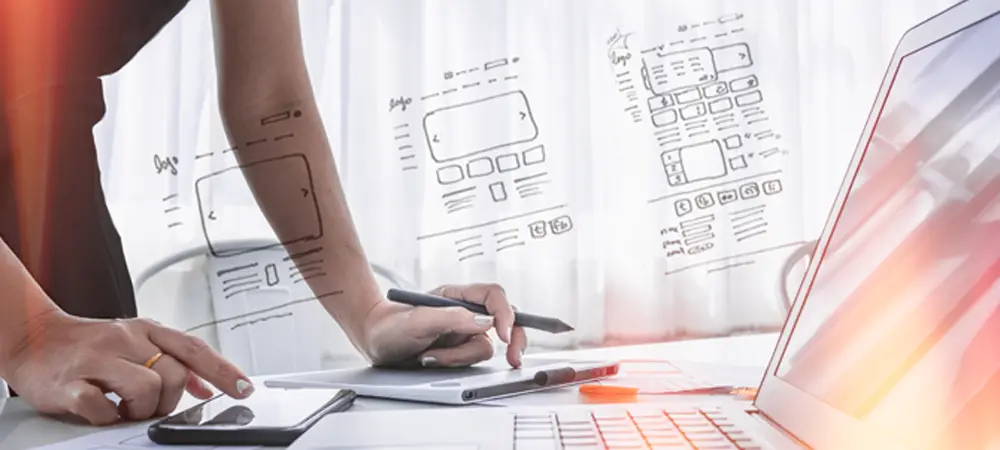Foundations of User Experience Design


User experience design lies at the heart of modern digital space interactions. It spans from websites and mobile applications to software interfaces, and much more in between. At the very core of UX design lies the attempt to provide instinctive, meaningful, and pleasurable user experiences. This post explains the very basic principles, methods, and elements that build up effective UX design.
Understanding UX Design
The part of the user experience design that can be termed as the most integral concerns an increase in user satisfaction through increased usability, accessibility, and pleasure from the experienced interaction between a user and a product. This field bridges gaps between psychology, design, and technology with respect to the creation of seamless experiences.
Core Principles of UX Design
There are a few core principles of effective UX design, all of which revolve basically around the user’s needs and preferences.
a) User-Centred Design: A process in design where users are considered as leads with respect to the goals and behaviours in making design decisions.
b) Usability: It is basically how easy something is to use or navigate a product for an overall positive user experience with less frustration.
c) Accessibility: It makes sure that products are accessible to all users, irrespective of their abilities or disabilities.
d) Satisfaction: Making the user experience attractive, interesting, and enjoyable will motivate the continuity of the user’s dealing with the product.
e) Feedback: Taking the feedback from the user into the design process will help in its iteration for improvement continuously and see that the deliverable is per the expectations of the user.
Elements of UX Design
The good UX design framework consists of several components. Some of them are as follows:
a) Information Architecture: The content needs to be managed and structured so that it brings in order and intuitiveness for additional navigation and usability.
b) Interaction design: It involves deciding how users will interact with the interface through buttons, menus, gestures, or any other possible way. This will provide for a seamless user experience.
a) Visual Design: This makes use of typography, colour schemes, imagery, and layout to come up with designs that are both appealing to the eye and logically coherent in their identity.
b) Prototyping: Interactive prototypes let designers view their design concept but also test its usability and functionality before it is built.
c) User Research: A better understanding of the user behaviour, needs, and pain points can be known through research done via surveys, interviews, and usability testing.
f) Usability Testing: It discovers problems with usability quite early in the design with real users and provides a chance for iterative improvement.
Process of UX Design
The process of UX design normally adheres to a number of iterative steps to ensure a user-centred approach:
a) Research: It involves studying and collecting information about the behaviour, motivation, and goals of users through user interviews, surveys, and analytics.
a) Analysis: Research results are analysed to realise the pain points, preferences, and opportunities residing in the interaction.
b) Design: Docketing off these, wireframes, prototypes, and visual designs will then be made accordingly, based on the research insight and design principles.
c) Testing: Designs will iteratively be tested on the users for feedback in a bid to validate assumptions made and hence improve the user experience.
e) Implementation: Collaboration with developers to make sure that while the product is developed and deployed, it stays at a desired level of user experience.
Tools and Technologies
There are a lot of tools and technologies that help a UX designer in designing. These include:
a) Wireframing and Prototyping Tools: Tools like Sketch, Adobe XD, Figma can be used to create wireframes and interactive prototypes.
b) User Research Tools: Tools like User Testing and Optimal Workshop are at hand to assist designers in conducting user research and gathering feedback and analysing user behaviour.
c) Analytics Tools: Tools such as Google Analytics and Mixpanel inform about user interactions, behaviour flows, and performance metrics that aid in making design decisions.
Importance of UX Design
Good UX design adds value in several ways to both the user and the business:
a) Improved User Satisfaction: Usability and accessibility are increased, making the user satisfied, hence a better brand image.
b) More Engagement: Engaging and intuitive experiences will motivate users to use the product frequently.
c) Business Impact: The investment in the development of UX increases conversion rates, improves customer loyalty, and decreases support costs.
d) Competitive Advantage: It differentiates in competitive markets and offers superior user experience to attract more users.
Challenges in UX Design
Despite the benefits, there are several challenges in UX design that a designer needs to overcome. From negotiating the needs of stakeholders with the needs and expectations of users to designing for the demographics of users, devices, and platforms, this would become very dynamic. Detailed consideration in these areas will have to be adapted. Finally, continuous development in technologies like AI, AR/VR, and voice interfaces needs equally fast-paced learning and adaptation.
Future Trends in UX Design
Some of the trends which may shape the future of UX design include:
a) Personalisation: A process of using insights from the data to personalise the user experience per individual preference and behaviour.
b) VUIs: Designing interfaces that use voice commands—freeing up the hands for other operations.
c) AR and VR: Digital and Physical worlds converge in the creation of immersing experiences.
d) Ethical Design: Power users by giving them more control over privacy, security, and ethical practice in design.
Conclusion
Basically, the foundation of UX design acts as a channel toward rendering intuitive, accessible, and most importantly, pleasurable user experiences. With insight into the needs of users, tools in design, and embracing technology innovations, it aids the UX designer in innovating and presiding over the future of digital interactions.
It gets to the roots of the UX design, striving to provide insight into the principles, methodologies, tools, and challenges that define this changing field to both inexperienced and experienced designers. By keeping the user at the core of design and embracing constant improvement, one will be able to make an effective experience that touches a chord with users and contributes to business success.
Authored By

Dr Bharti Arora
Assistant Professor (Sel Grade)
Department of Applied Sciences,
The NorthCap University, Gurugram
LinkedIn profile: https://www.linkedin.com/in/dr-bharti-a-b8a613b4/
Expertise areas: Biophysical Chemistry, Bioinformatics, Material Chemistry, Nanotechnology in Water Purification, CNT, Phase Change Materials, UX design, Design Thinking
